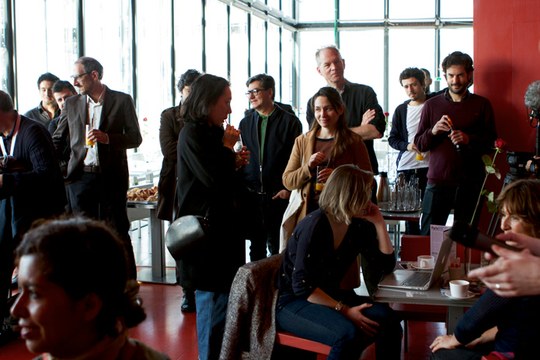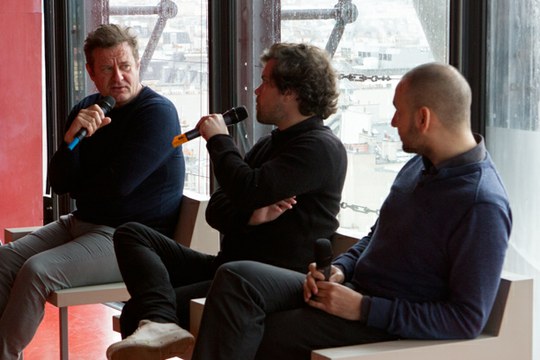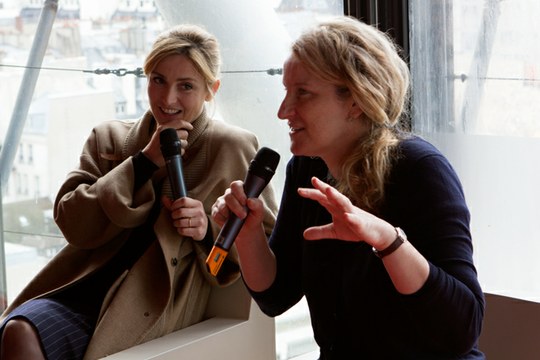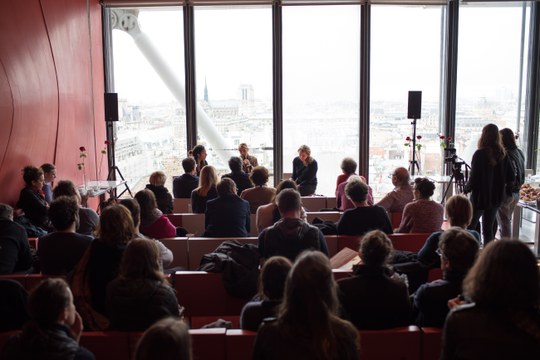ParisDoc Capsules 2018 report
Capsules #1 // Meet the guests
Monday, March 26, was a day of novelty within ParisDOC. For its fifth year, ParisDOC has set up Capsules for the first time. At the top of the Pompidou Center, in the heart of the restaurant Le Georges, the documentary professionals went to meet festival guests in an informal get together for a breakfast to get to know each other, to discuss and to talk about fundamental issues of their work.

Presented by Anaïs Desrieux, head of ParisDOC, and Andréa Picard, artistic director of the Cinéma du Réel, the guests then introduced themselves, one after another. The attendance was thereby able to meet Mark Peranson, head of programming at the Locarno Film Festival, editor-in-chief of Cinema Scope magazine and juror of the feature film competition, Léo Goldsmith, academic and co-director of the Brooklyn Rail magazine’s cinema section, as well as Bettina Steinbrügge, director of the Hamburg Kunstverein and former programmer for the Expanded Forum of the Berlinale, both members of the First Films and Short Films jury.
Alongside them were Gerwin Tamsma, programmer at IFFR (Netherlands), Gabor Greiner, acquisitions director at Films Boutique, Roland Loebner, coordinator of the DOK Film Market at the international documentary festival LOK Leipzig (Germany), Ina Rossow , head of festival at Deckert Distribution, Manuela Buono, founder and director of sales and acquisitions at Slingshot films, Sandro Fiorin co-founder of Figa Films, Davide Oberto head of the doc selection at Torino Film Festival (Italy) and co-director of Doclisboa (Portugal), Charlotte Selb, programmer for RIDM, Hot Docs, Cinéma Moderne and critic for 24 images (Canada) and Susana Santos Rodrigues, international consultant for Karlovy Vary (Czech Republic), Bildrausch Film Festival (Switzerland) and distributor for VAIVEM (Argentina).
Find out more pictures and the video of the event on our blog
Report written by Perrine Quenesson
Capsules #2 // The distribution of documentaries on new media by UnivresCiné
Wednesday morning at 11am, in the red lounge of Georges, at the top of the Pompidou Center, took place the 2nd Capsule, new event for professionals set up this year by ParisDOC. Hosted by Dominique Barnaud, Co-President of the Cinéma du Réel, this meeting was centered around the place of documentary in new technologies and especially in the era of platforms. For this, ParisDOC received Charles Hembert, director of publishing, and Romain Dubois, marketing manager at UniversCiné.

At first, the duo explained the principle and the role of UniversCiné which wear two hats as aggregator and contents publisher. It is composed of five platforms: two OTT (UniversCiné and the digital media library, co-edited by Arte) and three IPTVs on the home gateways. In addition, UniversCiné also has an SVoD offer, UnCut, which allows, on subscription, to have access to 40 selected films per month, renewed by 10 every week.
One of the first observations made by Charles Hembert about VoD is that 80 to 90% of the films consumed are novelties (four months after their release in theatres). But the documentary is more particular. The specificity of the latter being a greater longevity to reach its total number of spectators, contrary to fiction. This long-term value is reflected in numbers: thus on 500 000 rentals in the year on UniversCiné, 40 000 (or 8%) are made by the documentary, among them, 52% are made on pieces that are more than two years old, against 48% of news.
In France, when a documentary arrives on a platform, it becomes accessible for the first time to nearly 60% of the population because of the limited number of theatrical screens. Taking their own practice as an example, Charles Hembert specifies that the role to play by platforms, taking the opposing view of Netflix, Amazon or otherwise, is precisely to cut the large rental vectors such as comedy or action movies for to highlight other types of films such as documentary but also arthouse movies or short films. Especially since there is a real audience for the documentary and that it is not only a film buff one. Moreover, it is also very strong in EST (final purchase) because it is a type of work that we keep or that we offer because of its identity component.
But to attract new audiences, it is also necessary to organize the releases. The documentary has the particularity of being able to create communities around it and its director becomes the salesperson. First in theaters where he presents his film but later, as is the case on UniversCiné, by participating in editorialized interviews. The press is also an ally for the documentary because it is well supported as well as the non-media, be associations or communities. The main vectors to attract the public towards the documentary are the word of mouth, the #Top (created by the platform on a principle of enhancement of certain films) and the algorithm. For the director of publishing, the danger of algorithms is to lock the viewer into a certain type of cinephilia. He thus advocates the importance of editorialization by giving the example of Cinetek, VoD platform in which UniversCiné also participates, which, thanks to its principle of recommendation by filmmakers, will allow a work to be four times more seen than on a more general platform: “Our daily work is to create desire,” he says.
Charles Hembert also explains that digital is not yet ready to replace movie theaters, that the fantasy around VoD / SVoD is not yet ready to be realized. For example, when UniversCiné prefinanced a film, it takes two mandates: physical and digital. But the physical represents 80% of the investment against 20% for the digital, the first being still leader. However, if it is difficult to attract people to the documentary in VoD, it works very well in SVoD where it represents, at least on UniversCiné, about 25% of the films consumed. However, we must be aware, according to the editor, that the SVoD is a destruction of values compared to transactional VoD or physical video because for the price of one film, people watch six of them. This opinion, paralleled with the music industry, was tempered by Romain Dubois who explains that value is also created in the fact that the films are seen.
On the whole, the speakers underline that the VoD stagnates when the EST takes off. SVoD grows very gradually and will quickly represent 50% of the VoD market. In addition, consumer practices have evolved. Notably thanks to the democratization brought by Netflix, the consumption directly on the platform, and not through the home gateways, has increased from 10 to 53% of users. But few platforms in France offers the dual option VoD / SVoD except, in addition to UniversCiné, FilmoTV. Moreover the fragmentation of the market is complicated because eventually few new creations manage to hold on the long term: “Those who remain are those who have found a model” says Charles Hembert, citing also, as an example, Tënk, platform dedicated to documentary.
If it is difficult to predict the future of platforms and their impact on the cinematographic landscape. As far as pre-financing is concerned, it is complicated for SVoD platforms to get involved, especially since with the media chronology (in France), they would only have access to the film three years after its release (as opposed to 4 months for VoD). Moreover the arrival of big players like Amazon Prime, Apple or the future platform Disney / Fox put any form of prediction on hold.
Find out more pictures and the video of the event on our blog
Report written by Perrine Quenesson
Capsules #3 // Meeting with Rouge International
Friday, March 30, ParisDOC offered the 3rd and last Capsule of this 5th edition. This was the occasion of a meeting between the professionals and the two leaders of Rouge International, Julie Gayet and Nadia Turincev.

After a quick introduction from Anaïs Desrieux, head of ParisDOC, moderator Pamela Pianezza, journalist and photographer, briefly summarized the background and personality of each of the two women and the line-up of Red International which includes movies such as Raw, Mimosas, Faces Places, The Insult, The Ride or Of Rolls and Men. Pamela Pianezza also recalled the motto of the company which is “The universal begins when one pushes their kitchen’s walls”.
To the question « what is a film Rouge International ? », Julie Gayet and Nadia Turincev have demonstrated this claimed universality, their eclecticism while explaining that there were no specific types of film they want to do, that what they want above all is to be surprised: “We want to make films that we do not have the sensation of having already seen and our choice mainly depends on the uniqueness of the filmmaker’s gaze. We do not put films in boxes, no matter whether they are documentary or fiction, they just have to touch us with their themes and their approaches », they explained. If the choice of projects is based on the unanimity of the tandem, a bonus to the firm favorite is also one of their main way of picking a project.
Julie Gayet and Nadia Turincev have known each other since 1993. The first one is an actress, particularly interested in production. The second works in the production field but also as an artistic director especially for the Moscow Festival or in the selection committee at the Directors’ Fortnight. The desire to create Rouge International in 2007 was born from this wish to produce, to see the birth of authors and to accompany them: “One year after our launch, it was the financial crisis of 2008. So we had to review all our financing plans which were divided by three “explained Julie Gayet. By following a principle of honesty about the real price of films, the two women also quickly turned to the international market, particularly using the notion of equity to finance their film with foreign private funds.
If the idea of making some big movies to help financing the little ones crossed their mind, it’s not what they eventually opted for. Recently, they had the proof that their choice was the right one when they co-produced Serge Hazanavicius’s Tout là haut, a big budget film. They then realized that this type of economic model did not really suit them: “We tried to apply producing methods for arthouse movies on a film with a 10 millions € budget but it turned out not to be a very good idea.” The important thing for the duo is above all to be “coherent” in their approach to financing: “We are still looking for balance but we know that it is through the coherence that we will manage to win on all fronts. That’s also why we launched our distribution branch, “says Nadia Turincev.
Indeed, since last year, with the addition of Emilie Djiane to their team, Rouge International has created Rouge Distribution. After Off Rolls and Men last October, the company is currently distributing The Ride by Stephanie Gillard and is preparing the releases of Liu Jian’s Have a Nice Day, Olmo Omerzu’s Family Film and Philipp Jedicke’s Shut Up and Play the Piano. If the goal is not to only distribute films produced by Rouge, it is certain that this distribution organ is also an asset for them and their in-house productions: “We followed the film since its beginnings, which allows a long-term work and the development of a stronger strategy, and it also gives us the opportunity to have new funding, and ultimately save time.” This strategy is also established with the festivals that are central in the course and the notoriety of a film: “It is important to know which festival is made for which film. But also at which period of the festival it must be shown. It happened to us with Fix Me at Sundance, our first festival with one of our feature films. The movie was shown after the first weekend, when there was no one left! We learned the lesson well, we will not have it any more! If the festivals are important, for the release, it is also necessary to think broader and to be interested in the context of the release (exhibitions, theater’s plays…) which could suit us or with which we could associate. We must think globally.”
Production, distribution, a willingness to go to international sales too? ” Maybe ” said Nadia Turincev with a mysterious attitude.
Finally, in terms of staff members, the number of them is very changing but the company can not go beyond eight employees, for the moment, for budgetary reasons. In the same way, the premises have changed, from Julie Gayet’s living room to their own offices including editing tables. Which is handy, especially for smaller films. In addition, the tandem is particularly interested in post-production: “In most foreign films that we produce, we participate a lot in the development of the scenario but we do not attend the shooting, which is often followed by the local production team. We often take over the film at the time of editing.
With award-winning films in multiple festivals and nominations in many awards ceremonies, what can we wish for Julie Gayet and Nadia Turincev: “A selection in Competition at the Cannes Film Festival, it would be really good”. Let’s find out on April 12th.
Find out more pictures and the video of the event on our blog
Report written by Perrine Quenesson
